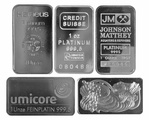Does platinum tarnish?
Platinum - the chemical symbol PT - is classed as a ‘noble’ metal. This means it is unreactive, and pure Platinum will not tarnish, corrode, rust, or change colour over time. Platinum alloys of course could change this, depending on the metal(s) used, and the purity of the alloy. Generally speaking platinum alloys usually retain a fairly high purity however, and should still be tarnish resistant.
Silver investors will likely know that, if left exposed to air for prolonged periods of time, silver can develop a dark tarnish as it reacts to sulphur. This won’t happen to platinum, so coins and bars should not discolour over time. There is however one way in which the distinctive white lustre of platinum can disappear: a patina.
Does platinum tarnish or rust?
Platinum’s lack of reactivity is what stops it rusting or tarnishing. This also makes it hypoallergenic, and is one of the reasons platinum is a favourite with jewellers.
Platinum, however, can develop a patina; this is a broad term that, in the case of platinum, refers to an aged look. A patina can form in as little as six months for well-worn jewellery, and the lustre of platinum can be lost quite quickly because of the metal’s inherent malleability.
Despite being incredibly durable, platinum can deform and be shaped very easily without breaking. This makes it very useful for jewellers and other industries, but also means it can be scratched quite easily. The patina is developed due to the way light interacts with fine scratches on the surface of the platinum.
For investors buying platinum coins and bars this shouldn’t be an issue, as the platinum is unlikely to be handled regularly. If, however, you do have a platinum coin or bar that has a patina, it can be polished safely, as the durability means platinum isn’t worn away when polished. Instead the scratches are buffed out, bringing back platinum’s natural lustre.
Like gold, platinum offers investors the chance to own a physical asset; an asset that won’t tarnish over time, and enjoys high industrial demand. Platinum is also 30 times scarcer than gold, meaning supply is much more limited.
- How To Buy Gold
- How to Buy?
- Payment Options
- Delivery Options
- Gold Storage
- Storage at Brink's
- Gold Investment Guide
- Why buy gold?
- Is gold a good investment?
- Why physical gold?
- Best time to buy gold?
- Gold bars vs coins?
- Gold vs Silver
- Gold - Silver Ratio explained
- VAT on bullion
- CGT on bullion
- Legal tender coins
- Top 5 Gold Investments
- Top 5 Silver Investments
- Gold vs ISAs
- Gold vs Buy-to-Let
- Gold vs FTSE 100
- Gold vs Bitcoin
- Where to buy gold?
- Why buy from us?
- Where to sell gold?
- Coin Shops
- Gold Price Forecasts
- Top 10 Gold Producers
- Top 10 Gold Reserves
- Gold Britannia vs Sovereign
- Britannia coin designs
- Sovereign coin designs
- Sovereign Mintages
- Sovereign mint marks
- British coin specs
- What is a proof coin?
- Royal Mint bullion
- The Queen's Beasts
- Royal Mint Lunar Coins
- Bullion Refiners
- British coin mints
- Krugerrands
- Gold Tola - India & Pakistan
- Bullion Index








